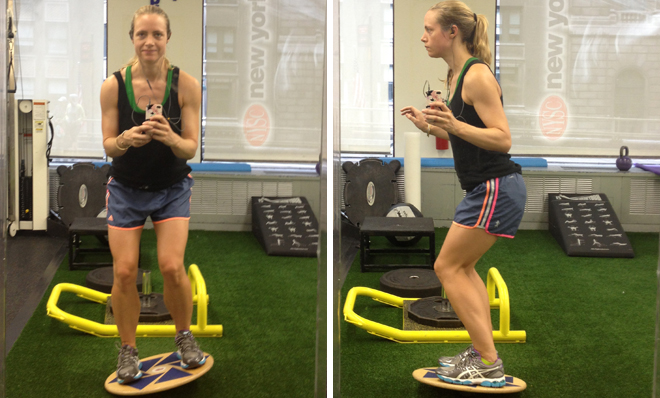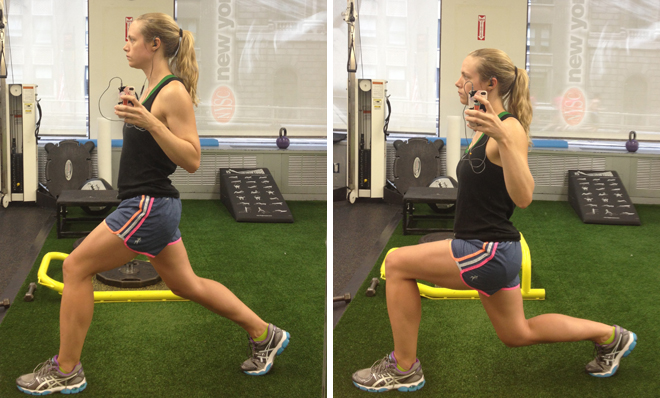Diary of an injury-prone runner: Week 3 training for the New York City Marathon
I love to run. My body would rather I didn't.


This week was all about getting down to the business of recovery. Yes, technically, I have been recovering for more than a month, ever since the first telltale strains and tightness took hold of my right calf and totally decimated my running ability. But this week, I got serious.
I put my muscles in the capable hands of a professional, one Steven L. Braverman, P.T., P.C., of Restore Physical Therapy. The Restore offices are on the 18th floor of a pre-war building on 7th Avenue and 34th Street in that beauty-forsaken midtown area I like to refer to as the Penn Station Pit. This is an unfortunate Manhattan destination. During morning and evening rush hours, so many people stream up from or down to the commuting hub that the sidewalk overflows and hurried, business-casual workers are forced to battle bikers and cabbies for space on the street. It's not pretty.
But, blessedly, the Restore offices are. Braverman's corner spot offers you fantastic downtown views of the city (I'll get a photo next time). And it is in this sun-drenched space that I spent three of my 7 to 8 a.m. hours last week trying to make miracles happen.
The Week
Escape your echo chamber. Get the facts behind the news, plus analysis from multiple perspectives.

Sign up for The Week's Free Newsletters
From our morning news briefing to a weekly Good News Newsletter, get the best of The Week delivered directly to your inbox.
From our morning news briefing to a weekly Good News Newsletter, get the best of The Week delivered directly to your inbox.
When I first met Braverman early Monday morning, I told him about my injury, ending my sad story with some sort of pity party invitation to the tune of: "I'm getting really depressed at the thought of not being able to run." To which Braverman responded without hesitation: "Why? You'll be fine." It is those last three words that I have since clutched like a security blanket.
Braverman says I do not have a major tear in my calf. Rather, my injury likely stems from a series of micro tears that have occurred since the initial injury some three years ago. All those tiny micro tears build up scar tissue that fills into my muscle fibers like spackle, hardening to the point that my calf tears further instead of flexing as it should.
There are two parts to my physical therapy. The first is breaking down that pesky scar tissue. There are a number of slightly tortuous ways that Braverman and his delightful team do this. One is using an ultrasound. (No, it's not the same as a pregnancy ultrasound, we're not trying to find the faint heartbeat of my injury.) This one works with sound waves that are sent into and absorbed by the body's soft connective tissues, like scarring, tendons, and such. You don't feel the ultrasound, you only smell the minty ointment that is used with it.
What you do feel is the "massage" that Braverman administers with his mitt of a hand. After the ultrasound, he just gets right up into the calf muscle, kneading and digging, reading my face for signs of discomfort and pain that signal to him, "Yeah, that's the spot." Then he'll focus on said spot for awhile, which isn't so horrible because I'm a masochist who assumes pain is the only way to break up the bad stuff in my muscle. Bring it on, Braverman!
A free daily email with the biggest news stories of the day – and the best features from TheWeek.com
And then there's the electrical muscle stimulation, which is basically a modern day torture device. Electric currents are sent into the muscle through two nodes that are attached loosely to the skin around the injured area. You can turn the current up or down, so it can feel as low and annoying as a series of ants crawling on your skin or as high and painful as tiny knives testing the breaking point of your flesh. Unlike massage, when it comes to electric stim, pain does not equal progress. Braverman said I should be just be comfortable. So I learned to unclench my jaw and dial it back.

The second part of my recovery is strength and stretching. I like to think of myself as a tough cookie capable of near superhuman strengths. If you need help carrying your double stroller up three flights of subway stairs, I'm your woman. Moving a pullout couch out of your fifth-floor walkup? Give me a call. But when Braverman had me sitting at the weight machine dedicated to my hamstrings, I struggled to lift 10 pounds on repeat. Where is all of my freakish strength? Not hanging out in the back of my legs, apparently.
One of the strength and balance exercises that would also help build up leg muscle involved a board that had half of a ball attached to its underbelly. With that round surface on the ground, I placed one foot and then the other gingerly on the board, which then rolled depending on where I placed my weight. With both feet parallel to each other and my hips stationary, I shifted my weight in a circular fashion — from the balls of my feet, to the right side, to the heels, to the left side, and then back to the front — until my my point of view moved one clockwise quarter turn. Then I rolled the other way to return to where I started. And (always) repeat.

Braverman also taught me how to lunge properly. I thought I had this figured out from my years of gym classes, but I was way off. The lunge is all about moving down not forward. You actually have no weight on the calf muscle and most of the burn will explode from the back leg, instead of your front (though it's not on vacation, don't worry). You never want your knee to go over the toe and you want to keep the back heel lifted significantly. Trust me, it is so much harder this way.

After the first day of assessment and treatment, the Restore team sent me a personalized stretching workout to do at home. It consists of 10 tasks — 6 stretches and 4 floor exercises — that I should do twice a day. Doesn't sound so bad, right? Except that each exercise has 3 sets of 20 reps with a suggested 15-second rest between each one. It is downright tedious and takes the better part of an Orange is the New Black episode. On the plus side, I found that completing all of the mind-numbing tasks helps make me feel more in control of this situation.
Or, it did make me feel more in control, until Braverman had me test out the calf on Friday. Within moments of running on the treadmill at a leisurely pace I could feel that old nagging soreness in my muscle. I felt instantly defeated. While I was lying face down on a bed, electrifying the calf with some stim, Braverman came over and told me I could try to run again outdoors over the weekend, if I felt up to it. He suggested taking a day to rest and then seeing how I felt on Sunday, starting out slow and stopping the moment I felt any soreness. I agreed at the moment, but after leaving the sunlit offices and distancing myself from Braverman's contagious optimism, I grew panicked over my progress, viewing the treadmill incident as yet another setback. I did not try to run. I kept myself active over the weekend, but my mind wandered into dark corners of defeat. After bumping into a friend who is also running this year's marathon, I asked how her training was going. She said she hoped to reach 16 miles in a week or so. When she asked me in return, I actually had to hold back tears as I explained my own stagnant situation.
Heading into my fourth week of run-less training, a question bubbles in the back of my mind: Am I just delusional to think I could actually run this thing?
I'm afraid to know the answer.
Well, that's a downer of a close. Please do enjoy your runs. And keep me updated on your progress — marathon or no — below. I could use some uplifting stories.
Read more training diary entries:
* Diary of an injury-prone runner: Week 2 training for the New York City Marathon
* Diary of an injury-prone runner: Week 1 training for the New York City Marathon
Lauren Hansen produces The Week’s podcasts and videos and edits the photo blog, Captured. She also manages the production of the magazine's iPad app. A graduate of Kenyon College and Northwestern University, she previously worked at the BBC and Frontline. She knows a thing or two about pretty pictures and cute puppies, both of which she tweets about @mylaurenhansen.
-
 What would a UK deployment to Ukraine look like?
What would a UK deployment to Ukraine look like?Today's Big Question Security agreement commits British and French forces in event of ceasefire
-
 Nicolás Maduro: from bus driver to Venezuela’s president
Nicolás Maduro: from bus driver to Venezuela’s presidentIn the Spotlight Shock capture by US special forces comes after Maduro’s 12-year rule proved that ‘underestimating him was a mistake’
-
 Artemis II: back to the Moon
Artemis II: back to the MoonThe Explainer Four astronauts will soon be blasting off into deep space – the first to do so in half a century
